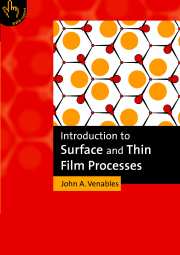Book contents
- Frontmatter
- Contents
- Preface
- Chapter 1 Introduction to surface processes
- Chapter 2 Surfaces in vacuum: ultra-high vacuum techniques and processes
- Chapter 3 Electron-based techniques for examining surface and thin film processes
- Chapter 4 Surface processes in adsorption
- Chapter 5 Surface processes in epitaxial growth
- Chapter 6 Electronic structure and emission processes at metallic surfaces
- Chapter 7 Semiconductor surfaces and interfaces
- Chapter 8 Surface processes in thin film devices
- Chapter 9 Postscript – where do we go from here?
- Appendix A Bibliography
- Appendix B List of acronyms
- Appendix C Units and conversion factors
- Appendix D Resources on the web or CD-ROM
- Appendix E Useful thermodynamic relationships
- Appendix F Conductances and pumping speeds, C and S
- Appendix G Materials for use in ultra-high vacuum
- Appendix H UHV component cleaning procedures
- Appendix J An outline of local density methods
- Appendix K An outline of tight binding models
- References
- Index
Chapter 6 - Electronic structure and emission processes at metallic surfaces
Published online by Cambridge University Press: 06 July 2010
- Frontmatter
- Contents
- Preface
- Chapter 1 Introduction to surface processes
- Chapter 2 Surfaces in vacuum: ultra-high vacuum techniques and processes
- Chapter 3 Electron-based techniques for examining surface and thin film processes
- Chapter 4 Surface processes in adsorption
- Chapter 5 Surface processes in epitaxial growth
- Chapter 6 Electronic structure and emission processes at metallic surfaces
- Chapter 7 Semiconductor surfaces and interfaces
- Chapter 8 Surface processes in thin film devices
- Chapter 9 Postscript – where do we go from here?
- Appendix A Bibliography
- Appendix B List of acronyms
- Appendix C Units and conversion factors
- Appendix D Resources on the web or CD-ROM
- Appendix E Useful thermodynamic relationships
- Appendix F Conductances and pumping speeds, C and S
- Appendix G Materials for use in ultra-high vacuum
- Appendix H UHV component cleaning procedures
- Appendix J An outline of local density methods
- Appendix K An outline of tight binding models
- References
- Index
Summary
This chapter gives, in section 6.1, some generally accessible models of metallic behavior, and tabulates the values of work function and surface energies of selected metals. In section 6.2 we discuss electron emission properties of metals, concentrating on the role of low work function, high surface energy materials as electron sources; we also show that electron emission and secondary electron microscopy can be used to study diffusion of adsorbates. An introduction to magnetism in the context of surfaces and thin films is given in section 6.3.
The electron gas: work function, surface structure and energy
Free electron models and density functionals
Free electron models of metals have a long history, going back to the Drude model of conductivity which dates from 1900 (Ashcroft & Mermin 1976). The partly true, partly false predictions of this classical model were important precursors to quantum mechanical models based on the Fermi–Dirac energy distribution. If words in the following description don't make sense, now is the time to take a second look at section 1.5. Modern calculations start from a description of the electron density, ρ−(r) (ρ−(z) in 1D) in the presence of a uniform density ρ+(r or z) of metal ions. This is the jellium model, where the positive charge is smeared out uniformly. At a later stage we can add the effects of the ion cores Δρ+(r) by pseudopotentials or other approximations.
- Type
- Chapter
- Information
- Introduction to Surface and Thin Film Processes , pp. 184 - 226Publisher: Cambridge University PressPrint publication year: 2000



